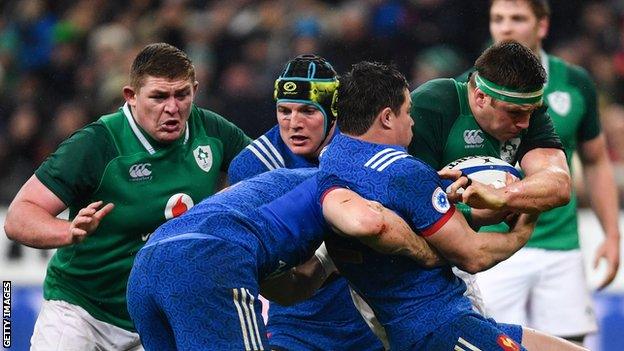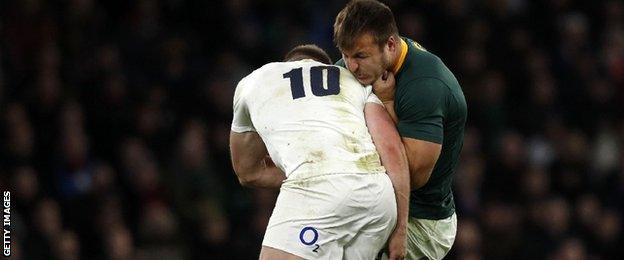Will the Six Nations bring less brutality and more beauty?
- Published

Last year's meeting of France and Ireland was a brutal contest
Guinness Six Nations |
|---|
Dates: 1 February-16 March |
Coverage: Watch live coverage on BBC TV, BBC iPlayer, Connected TVs and online; listen to match commentaries, shows and podcasts on BBC Radio 5 live, sports extra and BBC Sounds; follow text updates on the BBC Sport website and mobile app. |
The 2018 Six Nations got off to a dramatic start with the kind of high-octane, guilty pleasure brutality that is now at heart of the modern game. After Wales put away Scotland in the starter, the main dish was served in Paris when France hosted Ireland.
Joe Schmidt's team secured victory with a late, late Johnny Sexton drop goal, a moment that only came about in the first place after his forwards had trucked it up through the controlled explosions of 41 phases. "We had to go into a deep, dark place to win that match," said CJ Stander, the Irish number eight.
If it was difficult for Ireland then imagine what it was like for the French. Their forwards alone made 187 tackles in that game, their captain, Guilhem Guirado, making 31 all by himself. It was savage stuff.
On Friday, the championship begins anew when France host Wales. The electricity is already crackling, the sense of anticipation bouncing off the ceiling. You'll read many scene-setters that will catalogue the merits of each of the six nations, the strengths and weaknesses, the key men, the dark horses. This isn't one of those previews.
This is an anti scene-setter, an examination of what has happened in rugby since the last Six Nations concluded with an Irish Grand Slam at Twickenham. The injuries, the retirements, the fatalities, the law suits, the myriad drives to make the sport safer and the collective uncertainty about how the hell you do it.
'Rugby is toiling amid a crisis'
Rugby is a beautiful game, but it's also sick. Good people out there are doing their damnedest to bring forward data to assist studies to add to the greater understanding of the problem, but this past year has seen us turn away in horror at some of the things that have gone on. Weeks like this might serve as a distraction, but this is a sport toiling amid a crisis.
Adrien Descrulhes, a 17-year-old amateur player, was found dead in his bed in France after suffering a blow to the head on the field, which was followed by a haemorrhage. Louis Fajfrowski, a former French under-20 international, died in his changing room after a heavy tackle that brought on a heart attack. Nicholas Chauvin, an 18-year-old in the Stade Francais academy, died after getting caught in a two-man tackle that broke his neck. Nathan Soyeux, 23, died after suffering an adverse reaction to a tackle in a game in Dijon.
Four young Frenchmen, all gone in less than a year. If only the tragedy ended there. In May, an 18-year-old Canadian, Brodie McCarthy, died after a head collision in a schools match. In September, 31-year-old Kyle Barnes, passed away from a brain injury after a club match in South Africa. This month, Faiva Tagatauli, a 27-year-old Samoan, died four days after a suffering a bang to the head on the field of play.
Seven fatalities in rugby's name in the 10 and a half months since the last Six Nations concluded. Let nobody talk about freakish occurrences. One death might be a freak. Seven is not.
'Work is being done, but questions persist'
After the death of the four boys in France, L'Equipe wrote an editorial: "Rugby kills because it believed preparation protected everything, that the players' bodies could take more tackles, could take harder, higher tackles often made by two defenders simultaneously. Rugby kills because it did not want to see that it could kill."
After the horrors, the French Rugby Federation convened discussions about player welfare and injury prevention and announced a global forum to be held in March to pore over ways to make rugby safer. Some measures are already in place in youth rugby, but you can't analyse the trauma in France without raising the troubling testimony of the French neurosurgeon, Professor Jean Chazal of Clermont-Ferrand.
In August, Chazal described rugby as a "combat sport." More than that, he said that he was dismissed from French rugby's medical advisory board because he was so out-spoken about the risks of playing rugby. "They told me you have to be quiet," he said in an interview with Midi-Olympique.
A month before Chazal went public with his concerns there were four hugely distressing episodes in schools rugby in Queensland, Australia when, in the space of weeks, Oliver Bierhoff, aged 18, James Kleidon, 17, Conor Tweedy, 16, and Alexander Clark, 15, all suffered serious spinal injuries when playing rugby. No foul play was involved. In the review, all four incidents were deemed desperate accidents.
This is morbid, right? This isn't getting you in the mood for the big stuff on Friday night and Saturday afternoon. We could write a hundred features on the inspirational qualities of rugby. We could stay here for hours on end citing the joys of a great game. But the game needs help. Or more help.
There's been valuable work done - and it's continuing to be done - on raising awareness about concussion and hardening the penalties for dangerous tackles and trialling new laws about legal tackle height based on the analysis of mountains of data. But the questions persist.
Where is rugby heading? Can this carnage be stopped? When does an acceptable level of risk become too much risk? How much attrition is too much attrition? At what point do (more) parents grow uneasy about sending their sons and daughters to rugby?
'Scary' injury data illustrates issue
Jamie Cudmore, the former Clermont and Canada second-row enforcer, has spent time in a French court this month, attempting to prove that his former club played fast and loose with his health. Cudmore suffered awfully from concussion.
Sometime this year, the former Sale scrum-half, Cillian Willis will become the first player to sue an English club, and two medics, for alleged clinical negligence. Willis had to retire at 28 due to concussion related issues.
The last 12 months have brought the highest total of early retirements through injury, among them the Lions colossus Sam Warburton (gone at 29 with neck and knee problems), the former Wallaby Rob Horne (who bowed out at 28 after suffering paralysis of his right arm in a game in the Premiership) and the Springbok Pat Lambie (aged 28 and a victim of concussion that left him still living with the migraines and the eye irritations nine months after the last incident happened).
That's a recurring theme. During the year, the former Ulster, Ireland and Lions centre, Jared Payne, spoke about his own retirement through concussion in 2017 and how, 18 months later, he continues to feel the symptoms. Ben John, the Ospreys centre who retired this month at 27, said that despite not playing for a year he, too, still feels the effects of brain injury. An aversion to bright light, a lack of energy, a lack of concentration, always in a fog, regular blurred vision.

Owen Farrell's tackle on Andre Oosthuizen was controversially ruled legitimate in the final play of England's autumn win over South Africa
The RFU trialled a new tackle height law in the second tier of English rugby - lowering the permitted line of the tackle to below the arm-pit - but had to abandon the plan when data showed that incidence of head injuries had shot up by 67%.
The governing body at Twickenham, the Premiership and the English Rugby Players Association got together to produce their annual audit of injuries, a painstaking piece of work that all other unions and leagues should copy. They've being producing this valuable research since 2002.
The latest results show a massive spike in injuries in England training sessions - yes, training sessions - and a continuing of the trend that places concussion as the most commonly reported injury in professional rugby. Among the recommendations were stricter sanctions for higher tackles. Simon Kemp, head medical officer for the RFU, called for the sport to consider significant law changes to combat the severity of the injuries recorded.
In the wake of the report, Billy Vunipola, of Saracens and England and one of the planet's top players, was asked for his response. "Scary," he said, before talking about the reality of his world. "Defences have just become so unbelievably tough to break down and sometimes the only way to break it down is to run over or run through people."
We'll be seeing a lot of that this weekend and in the weekends to come. And most probably we'll revel in the intensity and the aggression and the ferocity bordering on monstrosity while conveniently suspending fears about the possible impact of the intensity and the aggression and the ferocity bordering on monstrosity. It's easier that way.
As PT Barnum might have said when selecting the bearded lady and the human owl and the two-headed boy in his Victorian Circus XV, the show must go on. And what a show.